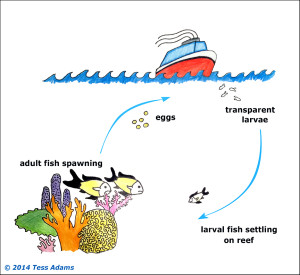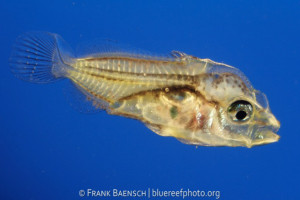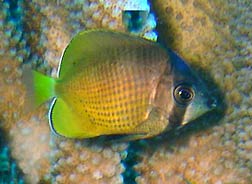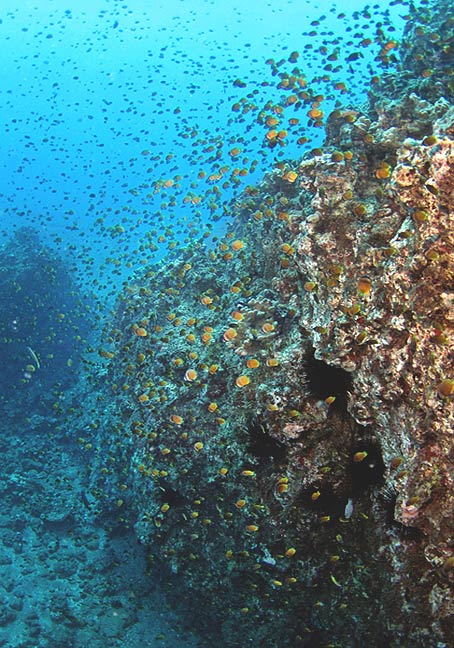Have your eyes ever beheld so many individual things that they felt full? That is the way my eyes felt three weeks ago while diving off of Molokini and south Maui. They felt so full that I actually had the sensation they were itching.
This is because on July 8 thousands of juvenile Blacklip Butterflyfish (Chaetodon kleinii) appeared overnight on reefs at Molokini and parts of south Maui. A month later on Aug. 4 another “shipment” arrived bringing the numbers into the estimated tens of thousands. And then a week later on Aug. 11, there was another astounding settlement which seemed to bring the numbers into the hundreds of thousands or millions. And these really were three distinct events. One day we were diving and everything was normal. The next morning, we descended and it looked like this:

Hundreds of thousands of juvenile Blacklip Butterflyfish (Chaetodon kleinii) settled at Molokini in the summer of 2014. Photo: Pauline Fiene
Yes, it is an exceptional summer for numbers of newly settled juvenile fish (called recruits) of many species throughout the Hawaiian islands – various surgeonfish including yellow tangs, goatfish, other butterflyfish, parrotfish, trumpetfish and others. But, massive numbers of Biblical proportions seem to have occurred only with the Blacklip Butterflyfish, and have taken place mainly at Molokini and off the Makena area of Maui (with large, though not this massive, numbers reported in north Kohala on the Big Island and on the north shore of Oahu, and few to none in West Maui, Kihei or Maalaea, the Kanaio Coast of Maui or the island of Lanai).
Not wanting to use the word ‘Biblical’ lightly, I thought I’d try and put a number on this incredible event. So, I took the photo of a section of reef at Molokini (above) and estimated the linear distance in inches contained in the photo. I then counted the number of fish visible in the photo and arrived at 16.8 fish per linear inch of visible depth. And then I multiplied 16.8 by the estimated number of inches around the outside rim of Molokini and along the inside of that same rim. The number…….. are you ready…….. was over 1.7 million Blacklip Butterflyfish.
This estimate is based on the number of fish that could be counted in the depth range visible in the photo (about 20-40 feet). The fish actually extended more than four times as deep – down to 170 feet in places, potentially doubling or tripling this number. The estimate also does not include those distributed throughout the center of the crater. On the other hand, although the fish numbers appeared similar around the entire outer rim and along the inside, the surface area of acceptable habitat might not be as high in every part of the rim as it is in the photo. So obviously, this must be considered a rough approximation. When the tens of thousands of Blacklip Butterflyfish juveniles off of south Maui are included (another rough estimate based on a photo count – photo below), a safe statement to make would be that at the peak (the week of August 11) there were probably in excess of two million Blacklip Butterflyfish juveniles in the Molokini and south Maui areas that we dive (Wailea and Makena).
What on earth could cause such an epic show of nature’s ability to procreate?
Two of the most likely contributors to such numbers are the survival of an unprecedented number of larvae, and currents which concentrated and then brought the larvae near the islands.

Understanding larval survival requires knowing about the life cycle of most reef fish. A pair of adult fish release their eggs and sperm into the water at precisely the same moment and no parental care follows. Within a couple days the fertilized eggs hatch and tiny transparent larval fish only a few millimeters long emerge to develop for weeks or months. This takes place up in the water, not on the reef where the fish will eventually reside. This is also where the vast majority of them die.* This summer, however, for reasons unknown, massive numbers of larvae survived.

A larval butterflyfish 28 days after hatching from the egg. It is only 6 mm long. Used with permission from Frank Baensch (bluereefphoto.org)
The larvae that make it through that critical period of 2-3 days post hatching, will, when developmentally ready, detect the proper habitat on the reef by smell or sound or other signal. They will swim down to the reef, often still in a partially transparent form, tuck into a crevice in the reef and begin to take on the colors of the juvenile fish. This process, called metamorphosis, is almost completely under the radar as far as we divers are concerned. We do not see the larvae up in the water and we very rarely see the transition stages once they settle on the reef. By the time we notice them, they are juvenile versions of adults.

A juvenile Blacklip Butterflyfish, about 30 mm long. Photo: Pauline Fiene
The juvenile Blacklip Butterflyfish, however, appeared overnight, as fully formed juveniles. Instead of arriving on the reef as larvae, scientists have learned that a minority of species metamorphose in the plankton and arrive on the reef as juveniles. This strategy might have been key to the massive scale of the Blacklip Butterflyfish settlement here on Maui. Most larvae have an internal clock ticking, so that when they are at the right developmental stage they have a limited window of time to detect suitable habitat and swim to it. If currents do not bring them close enough to a reef habitat that they can swim to, they die, unable to find shelter and the food they require. But, because the Blacklip Butterflyfish apparently has the ability to metamorphose into its juvenile stage in the pelagic environment, and because it is a plankton eater (and not dependent on eating algae or sponge or invertebrates, etc), it can survive longer in the planktonic environment, giving it a few more days for currents to bring it close enough that it can swim to the reef environment that it needs.
In addition to larval survival and “helpful” currents there are other factors that could have played a part in this wondrous settlement of juvenile Blacklip Butterflyfish. Some of these are fertility of the adults that spawned the eggs to begin with, sea conditions such as temperatures that are favorable to the eggs and developing larvae, plentiful food for the larvae, low predation on the larvae and probably other factors which we do not even know about yet. Most likely, this once-in-a-lifetime event was a fortuitous combination of two or more of these factors.
Whatever the reason, these fish are, unfortunately, probably not here to stay. Conditions in the plankton were clearly excellent for the larvae, but their requirements as adults living on a reef are completely different. Just a week after the August 11 settlement, the numbers had decreased slightly. Previous large settlements have shown that numbers continue to drop, most likely through predation and competition for a limited food supply.

Thousands of Blacklip Buttterflyfish settled in the Makena area of Maui. There are over 2,400 fish in this photo. Photo by Pauline Fiene
You could dive your whole life and never be witness to an event like this. In the memory of this generation of Maui divers, obvious settlements of exceptional scale have happened only three times in the past 30 years on Maui: 1984 with Fantail Filefish (Pervagor spilosoma – estimated at tens of thousands); September 2008 with Blacklip Butterflyfish (tens of thousands) and our current July-August 2014 Blacklip Butterflyfish settlement in the probable millions.
Events such as this one are a great opportunity for us to learn about the life cycles of marine animals that determine how our reefs are populated. Life cycles which are happening all around us all the time, but not in a way that we notice – until it makes our eyes itch.
by Pauline Fiene
You can read more in Part Two –
Juvenile Blacklip Butterflyfish (Chaetodon kleinii) swarm divers and turtles in competition for food
******************************************************************************
*A 2014 paper (V. China, R. Holzman. Hydrodynamic starvation in first-feeding larval fishes. Proceedings of the National Academy of Sciences, 2014; 111 (22): 8083 DOI: 10.1073/pnas.1323205111) reports that 90% of fish larvae die from what the scientists call hydrodynamic starvation, which is the inability to eat due to the viscosity of the water preventing the larva’s ability to propel itself forward. The water drag on such a tiny 3 mm larva keeps it from being able to lunge at and inhale the planktonic food, so it starves.

Comments 3
Pauline:
This is a great article. Geri & I wish we were able to see it.
I’ve been coming to Maui and diving for the past 30 years. I’ve NEVER seen anything like what I saw on 10/1/2014 at Molokini. It was truly amazing to see these fish in these numbers. Everywhere you look, you are simply overwhelmed by the number of fish seen. A once in a life time opportunity to witness. Thanks Pauline!
Pingback: Part Two - Juvenile Blacklip Butterflyfish (Chaetodon kleinii)